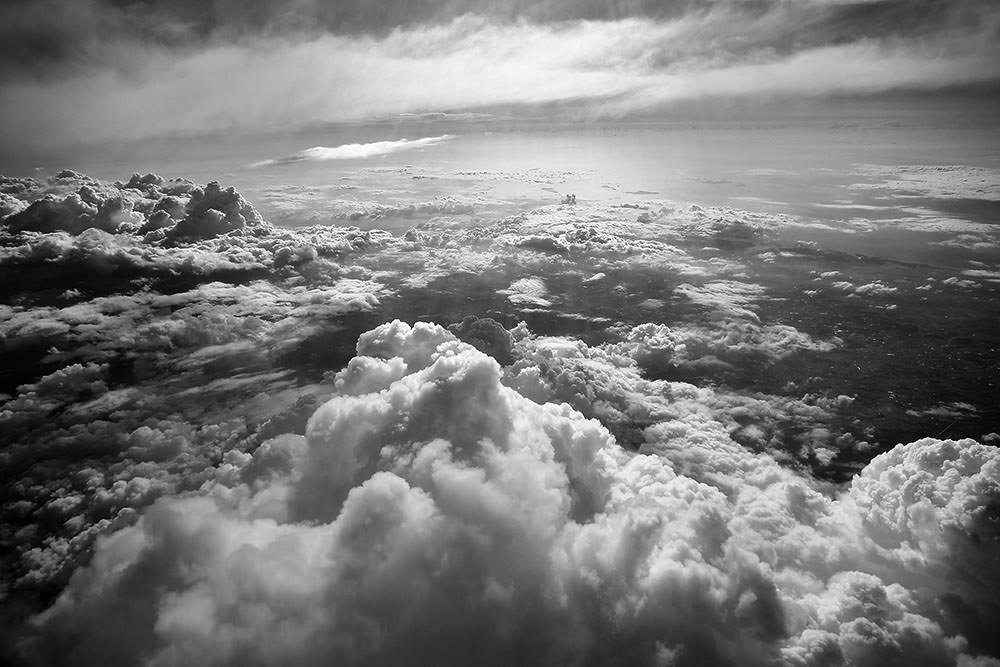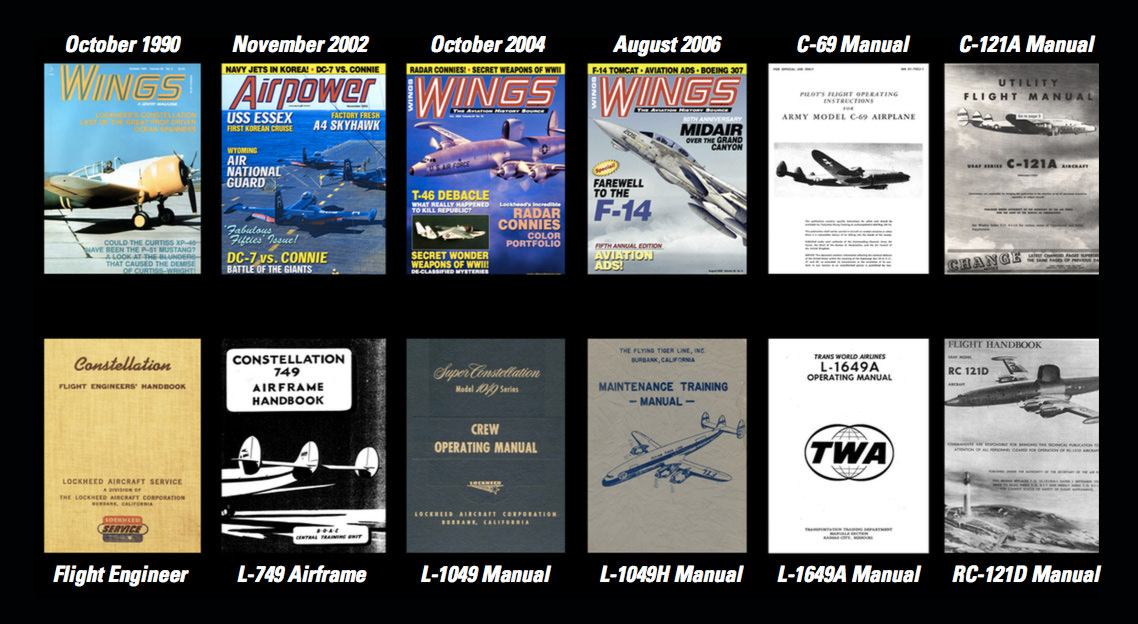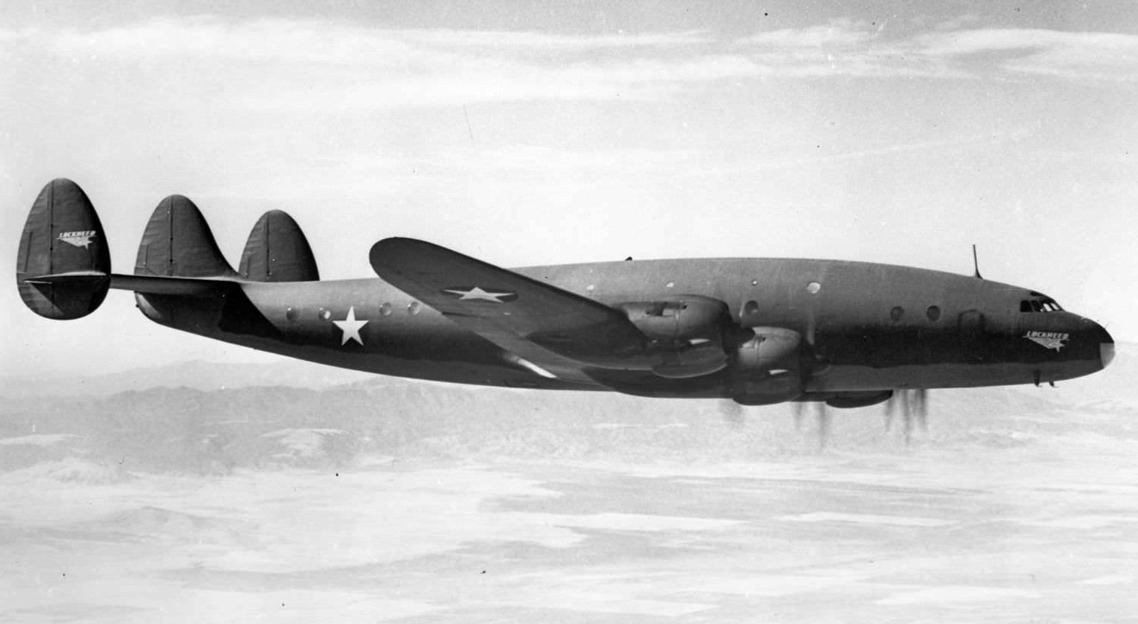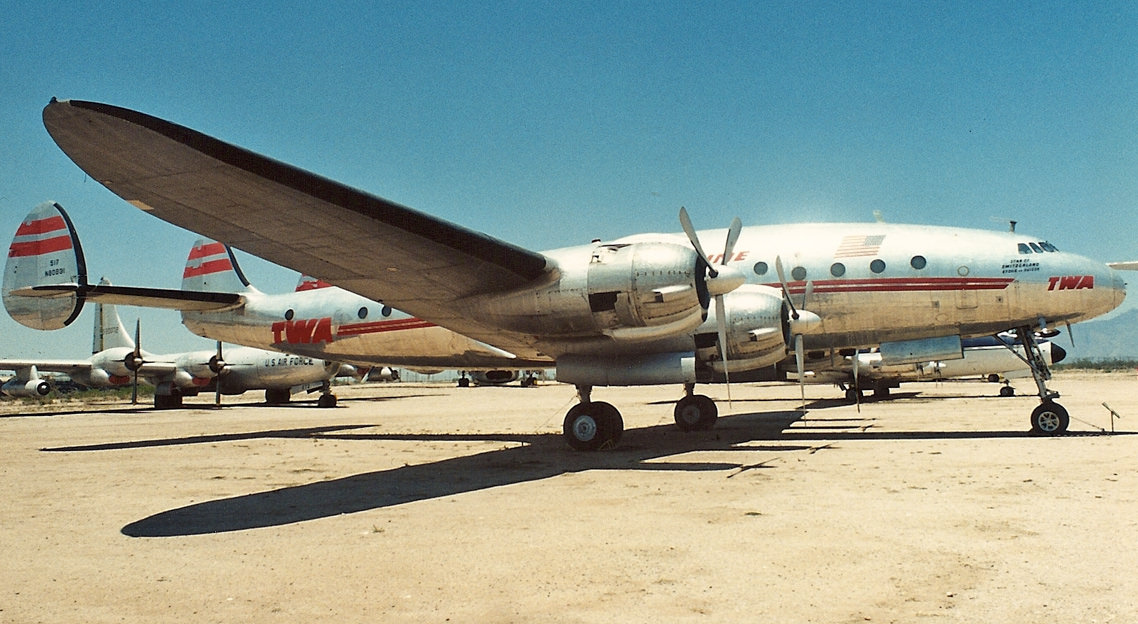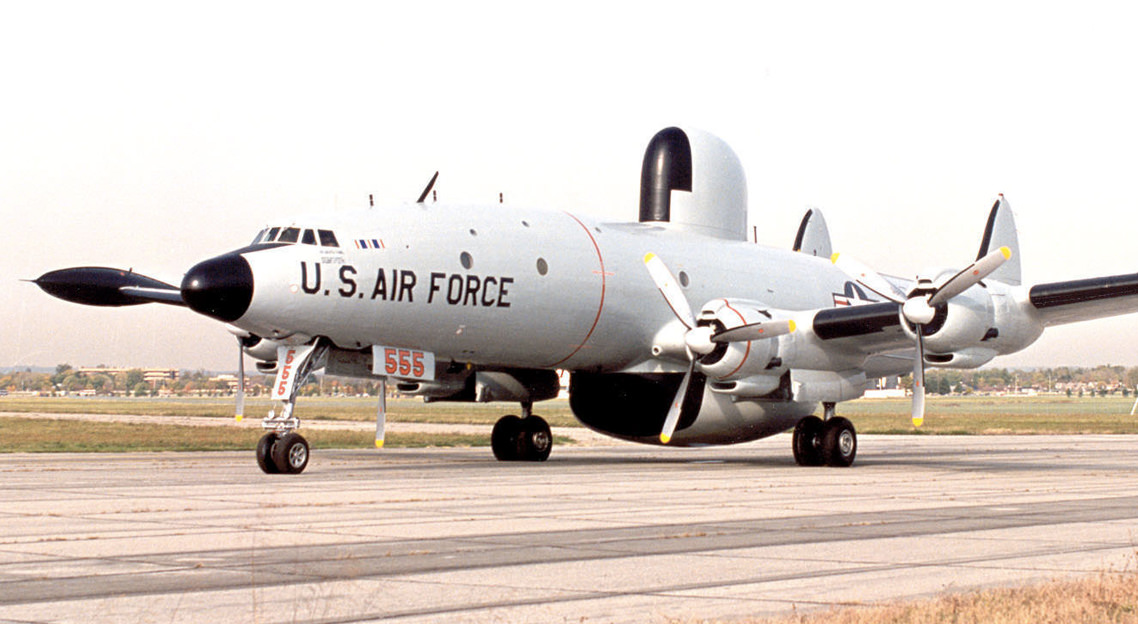Price: $24.95
- 4 magazines, 8 manuals, & photos
- PDF contains 2,610 pages
- Content is keyword searchable
- Print a personal copy
- Pay via PayPal or Credit Card
- International orders welcome!
- Download files upon payment
October 1990
- Lockheed’s Constellation
- Curtiss XP-46
November 2002
- USS Essex: First Korean Cruise
- A-4 Skyhawk: Factory Fresh
- Wyoming Air National Guard
- DC-7 vs. Connie: Battle of the Giants
- Fabulous Fifties Issue!
October 2004
- T-46 Debacle – What really happened to kill Republic?
- Lockheed’s incredible radar Connies
- Secret wonder weapons of WWII – Declassified mysteries
August 2006
- Farewell to the F-14
- 50th Anniversary – Midair over the Grand Canyon
- Aviation ads – Fifth annual edition
- Boeing 307
Manuals & Photos
- C-69 Operating Instructions 1945
- C-121A Flight Manual 1963
- Constellation Flight Engineers’ Handbook Lockheed
- L-749 Airframe Handbook BOAC
- L-1049 Operating Manual Lockheed 1952
- L-1049H Maintenance Training Flying Tiger Line 1957
- L-1649A Operating Manual TWA
- RC-121D Flight Handbook 1958
- Over 500 Lockheed Constellation photos!
Lockheed Constellation
L-1049G Specifications
Civilian Variants
Military Variants
On Display
Cutaway
General Characteristics
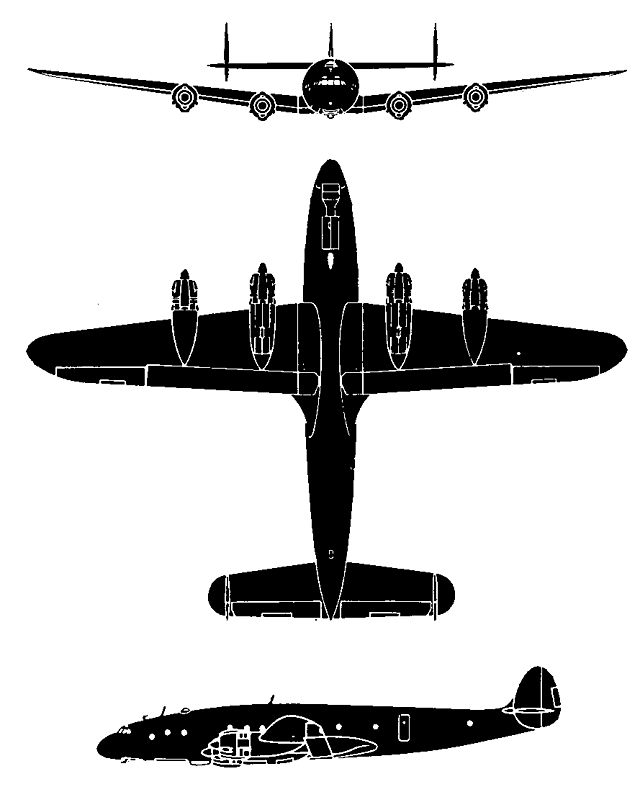
- Capacity: typically 62–95 passengers (109 in high-density configuration)
- Length: 116 ft 2 in (35.42 m)
- Wingspan: 126 ft 2 in (38.47 m)
- Height: 24 ft 9 in (7.54 m)
- Wing area: 1,654 ft2 (153.7 m2)
- Empty weight: 79,700 lb (36,150 kg)
- Useful load: 65,300 lb (29,620 kg)
- Max. takeoff weight: 137,500 lb (62,370 kg)
- Powerplant: 4 × Wright R-3350-DA3 Turbo Compound 18-cylinder supercharged radial engines, 3,250 hp (2,424 kW) each
Performance
- Maximum speed: 377 mph (327 kn, 607 km/h)
- Cruise speed: 340 mph (295 kn, 547 km/h) at 22,600 ft (6,900 m)
- Stall speed: 100 mph (87 kn, 160 km/h)
- Range: 5,400 mi (4,700 nmi (8,700 km))
- Service ceiling: 24,000 ft (7,620 m)
- Rate of climb: 1,620 ft/min (8.23 m/s)
- Wing loading: 87.7 lb/ft2 (428 kg/m2)
- Power/mass: 0.094 hp/lb (0,155 W/kg)
- L-049
- The L-049 was the original commercial airliner produced, although some earlier L-049s were begun as military transports and completed as airliners. L-649 aircraft followed, with more powerful engines, but all were soon upgraded to L-749 standard with long-range fuel tanks. 88 L-049, 14 L-649, and 131 L-749 were built, including conversions from earlier models and military versions. First 22 aircraft delivered as C-69 transports, first flight 9 January 1943
- L-149
- L-049 conversion to include extra wing fuel tanks for a longer range. Production versions were planned for Pan Am, but none were ever produced.
- L-249
- Company designation for the XB-30 bomber. Project cancelled in favor of the Boeing B-29.
- L-349
- Company designation for the C-69B. None built.
- L-449
- Unknown proposed civilian airliner version.
- L-549
- Company designation for the C-69C. One built.
- L-649
- R-3350-749C18BD engines with 2,500 hp (1,865 kW) each, seating for up to 81, first flight 19 October 1946
- L-649A
- Reinforced landing gear and fuselage
- L-749
- 6,145 US gal (23,640 l) of fuel providing the capability for non-stop transatlantic flights, first flight 14 March 1947
- L-749A
- Reinforced landing gear and fuselage
- L-749B
- Turbine powered. Project cancelled due to the absence of a suitable powerplant.
- L-849
- Planned version of the L-749, which would have had Wright R-3350 TurboCompounds.
- L-949
- Speedfreighter combi version of the L-849 with an 18 ft 4in fuselage stretch.
- L-1049
- First production version, 24 built.An 18 ft 4 in (5.59 m) stretched version with a maximum capacity of 109 passengers, square windows; all 1049C and later models had Turbo-Compound engines. Some later models had optional tip tanks. First flight 14 July 1951. 579 built, including military versions.
- L-1049A
- Company designation for the WV-2, WV-3, EC-121D and RC-121D.
- L-1049B
- Company designation for the R7V-1, RC-121C and VC-121E.
- L-1049C
- Civil variant of the 1049B for 110 passengers with four R-3350-87??18DA-1 Turbo-compound engines with 3,250 hp (2,425 kW) each, 48 built
- L-1049D
- Freight version of L-1049B with wing and fuselage modifications and a large cargo door, four built
- L-1049E
- Passenger variant of the 1049D, 28 built
- L-1049F
- Company designation for the C-121C.
- L-1049G
- Advanced variant with four R-3350-972??18DA-3 engines with higher METO power, ability to carry wingtip fuel tanks, 102 built
- L-1049H
- Passenger/freight convertible version of L-1049G with large cargo door, 53 built
- L-1049J
- Planned L-1049G with the wings of the R7V-2.
- L-1149
- A planned Allison turboprop version of the L-1049G and L-1049H.
- L-1249A
- Company designation for the R7V-2 and YC-121F.
- L-1249B
- Planned turboprop passenger version of the R7V-2/YC-121F.
- L-1349 unidentified. Dominique Breffort’s book claims no design with the L-1349 designation ever existed, possibly due to superstitious belief reasons.
- L-1449
- Proposed turboprop version of the L-1049G with a stretched fuselage and new wing.
- L-1549
- Planned stretched version of the L-1449.
- L-1649A Starliner
- Production version, R-3350-988TC18EA-2 Turbo Cyclone engines with 3,400 hp (2,536 kW) each. Long-range passenger aircraft designed to compete with Douglas DC-7C. The standard radome for the weather radar extends total length by 2 ft 7 in (0.78 m) over L-1049 without radome. New thin-section wing with a straight taper, and much larger fuel capacity giving a ferry range of over 6,880 mi (11,080 km), first flight 10 October 1956. 44, including the prototype, were built.
- L-1649B
- Planned turboprop version of the L-1649A.
- L-051
- Original company designation for the XB-30 project.
- L-084
- The XW2V-1 was a planned radar version of the WV-2 with the Starliner’s wings for the US Navy. It would have included four Allison T56-A8 engines and missiles for protection against attackers. Considerably different from its predecessors, given the production designation Lockheed L-084.
- XB-30
- Bomber version of the C-69. Was given model designation L-051 and later L-249.
- XC-69
- Designation for the prototype Constellation. One built. The C-69 was the original military transport version for the USAAF. All aircraft built during World War II were pressed into military service under this designation.
- C-69
- Original troop transport version. Almost all of this type were converted into L-049 airliners. 22 were built.
- C-69A
- Proposed long range troop version of the C-69.
- C-69B
- Proposed long range troop version of the C-69 designed to carry B-29 Superfortress engines to China. Was given model designation L-349.
- C-69C-1
- VIP transport aircraft, later designated ZC-69C-1. Only one aircraft was produced. Was given model designation L-549.
- C-69D
- Proposed VIP transport version.
- XC-69E
- Prototype XC-69 converted into an engine testbed. It was powered by 4 Pratt & Whitney R-2800 Double Wasp engines.
- C-121A
- The C-121 was the military transport version of improved L-749 introduced in 1948. Reinforced floor, cargo door in port rear fuselage
- VC-121A
- VIP transport aircraft, converted from the C-121A
- VC-121B
- VIP transport for use by the President of the United States of America
- C-121C
- R7V-1 with R-3350-34 engines with 3,400 hp (2,536 kW) each, based on L-1049
- JC-121C
- Two C-121C and one TC-121C used as avionics testbeds
- NC-121C
- One C-121C converted for permanent use as a testbed
- RC-121C
- USAF long-range airborne radar analogous to Navy’s WV-2
- TC-121C
- Nine RC-121Cs Converted as AEW trainers, subsequently became EC-121C
- VC-121C
- VIP version of C-121C. Total 4.
- EC-121D
- Big Eye/College Eye/Disco early warning variant, originally designated RC-121D
- NC-121D
- WV-2 converted to observe high speed objects in the atmosphere nicknamed the “Tripple Nipple”
- RC-121D
- WV-2 with wingtip fuel tanks, later redesignated EC-121D
- VC-121E
- VIP transport for use by the President of the United States of America
- YC-121F
- Two prototype R7V-1 with Pratt & Whitney T34-P-6 turboprops with 6,000 shp (4,476 kW) each
- C-121G
- 32 Navy R7V-1 delivered to USAF
- TC-121G
- Designation given to 9 C-121G converted into trainers
- VC-121G
- One C-121G given the role as a temporary VIP Transport
- EC-121H
- 42 EC-121D with upgraded electronics
- C-121J
- Redesignated Navy R7V-1
- EC-121J
- 2 EC-121D with upgraded electronics
- NC-121J
- 7 C-121J modified to send television broadcasts to troops in Vietnam
- VC-121J
- 4 C-121J converted for VIP use. One served with the Blue Angels.
- EC-121K
- Redesignated Navy WV-2 Warning Star
- JC-121K
- One EC-121K used as an avionics testbed
- NC-121K
- EC-121K used by the Navy
- EC-121L
- Redesignated Navy WV-2E
- EC-121M
- Redesignated Navy WV-2Q
- WQC-121N
- Redesignated Navy WV-3
- EC-121P
- EC-121K equipped for anti-submarine warfare
- EC-121Q
- EC-121D with upgraded electronics
- EC-121R “BatCat”
- EC-121K and EC-121P equipped to process signals from seismic instruments
- NC-121S
- Electronic warfare and reconnaissance version
- EC-121T
- Upgraded radar; One example is on display at Peterson Air and Space Museum, EC-121T photo.
- R7O-1
- The original US Navy designation of the R7V-1 based on L-1049D, R-3350-91 engines with 3,250 hp (2,425 kW) each
- R7V-1
- Re-designation of the R7O-1. Later redesignated C-121J
- R7V-1P
- One R7V-1 modified for Arctic use
- R7V-2
- Four prototypes with Pratt & Whitney YT34-P-12A turboprops of 4,140 shp (3,088 kW) each. Two were delivered as YC-121F prototype aircraft (see above).
- PO-1W
- Two maritime patrol aircraft equipped with search radar based on L-749, later re-designated WV-1.
- PO-2W Warning Star
- Long-range airborne radar aircraft, R-3350-34 or R-3350-42 engines with 3,400 hp (2,536 kW) each, based on L-1049, later re-designated WV-2.
- WV-1
- Re-designation of the PO-1W.
- WV-2 Warning Star
- Re-designation of the PO-2W. Later re-designated EC-121K.
- WV-2E
- Experimental version of WV-2 modified to carry a rotating radar dome similar to that of the Boeing E-3 Sentry. Later redesignated EC-121L.
- WV-2Q
- WV-2 equipped for electronic warfare, later redesignated EC-121M.
- WV-3
- Eight aircraft equipped for weather reconnaissance. Later re-designated WQC-121N.
- XW2V-1
- The XW2V-1 was a planned radar version of the WV-2 with the Starliner’s wings for the US Navy. It would have included four Allison T56-A8 engines and missiles for protection against attackers. Considerably different from its predecessors, given the production designation Lockheed L-084.
Civilian Constellations
-
On Display
-
- L-049
- C/N 1970 – on display at the Pima Air & Space Museum in Tucson, Arizona. This is a former C-69 transport, s/n 42-94549, that was converted for civilian service, and was one of the first TWA aircraft.
- C/N 2071 – on display at the TAM Museum, located in São Carlos, Brazil. Previously, it served as a children’s attraction at the entrance of Silvio Pettirossi International Airport in Asunción, Paraguay. It is painted in the markings of Panair do Brasil.
- C/N 2072 – parked adjacent to a flight school and cafe at Greenwood Lake Airport in West Milford, New Jersey. It was delivered as Air France’s first Constellation in June 1946 as L-049 F-BAZA, before being sold to Frank Lembo Enterprises in May 1976 for $45,000 for use as a restaurant and lounge. It was flown to the airport in July 1977, and, along with the airport, was sold to the State of New Jersey in 2000. In 2005, the interior was refurbished for use as a flight school office.
- C/N 2081 – on display in Aerosur livery, on the first ring road in Santa Cruz de la Sierra, Bolivia. It is known as El Avión Pirata.
-
- L-749
- C/N 2503 – on display at the Musée de l’Air et de l’Espace (The Museum of Air and Space) located at Paris-Le Bourget Airport near Le Bourget, France, 10 km north of Paris. It initially served with Pan American Airways, before being transferred to Air France, with whom it served until 1960. Afterwards, it was used by the Compagnie Générale des Turbo-Machines (General Company of Turbomachinery) as an engine testbed until December 1974.
- C/N 2553 – on display in TWA colors (although this aircraft never flew for TWA) at the Large Item Storage facility for the UK Science Museum at Wroughton, near Swindon. This aircraft was used by the Rolling Stones to transport equipment during their 1973 Australian tour. It is the only Constellation in the United Kingdom and is viewable on certain open days.
-
- L-1049 Super Constellation
- C/N 4544 – on display at the Museum of Flight in Seattle, Washington. It is painted in the markings it carried during its service with Trans-Canada Air Lines from 1954 to the 1960s. After TCA service, it was sold to World Wide Airways and later retired in Montreal by 1965; it was renovated as a restaurant and bar in and around the Montreal area, and sold and moved again to Toronto and used as convention facility by the Regal Constellation Hotel. It was sold again and stored at Toronto Pearson International Airport. Finally, it was sold to the Museum of Flight, restored in Rome, New York, and shipped to Seattle for display.
- C/N 4557 – on display at the Air Mobility Command Museum at Dover Air Force Base in Dover, Delaware. It is painted to represent a USAF C-121C, but was never actually delivered to the air force.
- C/N 4604 – on display at the Flugausstellung Hermeskeil, near Hermeskeil, Germany. It is a former Lufthansa Super Constellation, and was the actual aircraft that Konrad Adenauer flew into Moscow in 1955, when he negotiated the release of German POWs.
- C/N 4671 – on display near Munich International Airport at Munich, Germany. It is painted to represent Super Constellation D-ALEM, Lufthansa’s first long-haul aircraft of 1955.
-
- L-1649 Starliner
- C/N 1040 – on display in front of the Fantasy of Flight attraction in Lakeland, Florida.
- C/N 1042 – on display at OR Tambo International Airport, South Africa at the South African Airways Technical area. The aircraft is owned by the South African Airways Museum Society.
-
Under restoration or in storage
-
- L-1049 Super Constellation
- C/N 4519 – to display by the Amicale du Super Constellation located at the Nantes Airport in Nantes, France. It was delivered to Air France on November 2, 1953, and was upgraded to a L-1049 G in 1956, serving until August 8, 1967, having totaled 24,284 hours under Air France’s colors. After retirement, it was sent to Spain, to be registered EC-BEN, briefly flying humanitarian and medevac missions in Biafra. Aero Fret bought it in 1968, brought it back home to France, registered it as F-BRAD, and operated it on cargo hauls until 1974. When the Constellation landed in Nantes one last time to be scrapped, it was ultimately saved by Mr. Gaborit, who revamped it somewhat by his own modest means to finally park it near the terminal, accessible to visitors for a few years, until the Chamber of Commerce and Industry of the Nantes-Atlantique Airport bought it, to contract the Amicale du Super Constellation to undergo a complete restoration of the old aircraft.
- C/N 4825 City of Miami – parked on an unused runway at the Rafael Hernández Airport in Aguadilla, Puerto Rico. It was struck by a runaway DC-4 on February 3, 1992, resulting in damage to the right wing and main spar.
- C/N 4830 Star of America – to airworthiness by the National Airline History Museum in Kansas City, Missouri. This aircraft was originally built in 1957, stored for several years, and then delivered to cargo carrier Slick Airways. It was restored in 1986 by the Save-a-Connie, Inc. organization, later renamed as the National Airline History Museum. It was originally painted in red and white with Save-a-Connie, but was later repainted in the 1950s livery of TWA to resemble its original Star of America Constellation. The aircraft appeared at New York’s John F. Kennedy International Airport at the original TWA terminal designed by Eero Saarinen to commemorate the 75th anniversary of the airline with the paint scheme donated by TWA in Kansas City for the occasion. The Star of America has appeared at many airshows and was even used in The Aviator, the 2004 film depicting the life of TWA’s one-time owner Howard Hughes, the man often credited with helping design and develop the original Constellation series.
-
- L-1649 Starliner
- C/N 1018 – to airworthiness by Lufthansa Technik North America at Auburn, Maine. This aircraft was purchased at auction in 2007, along with C/N 1038, by the Deutsche Lufthansa Berlin Foundation. Lufthansa has built a hangar at the airport, which will allow the aircraft to be restored indoors.
- C/N 1038 – in storage at the Lewiston-Auburn Municipal Airport in Auburn, Maine. This aircraft was purchased at auction in 2007, along with C/N 1018, by the Deutsche Lufthansa Berlin Foundation, and stripped of all usable spares to support the restoration of C/N 1018.
Military Constellations
-
Airworthy
-
- C-121C
- S/N 54-0156 – Flies with the Super Constellation Flyers Association out of Basel, as The Breitling Super Constellation. Its restoration was sponsored by Swiss watch manufacturer Breitling, and is now registered in the Swiss Aircraft registry as HB-RSC. This Constellation is one of two flying in the world.
- S/N 54-0157 – Flies with the Historical Aircraft Restoration Society (HARS) out of Illawarra Regional Airport near Wollongong, Australia. Following its restoration, it was painted in pseudo-Qantas livery including the Quantas logo on the tail, (with the usual Qantas lettering along the fuselage and on the wing-end fuel tanks replaced with the word “CONNIE”) and registered as VH-EAG. This Constellation is one of two flying in the world.
-
On Display
-
- VC-121A
- S/N 48-0609 – on display at Jeongseok Airport on Jeju Island, South Korea. It was donated to Korean Air in 2005, and restored to airworthy condition at Tucson, Arizona. It was then ferried to South Korea, where it made its final flight, under its own power, from Seoul to its current location for static display. It has been repainted in 1950s Korean Air colors, and rendered unable to fly by the presence of unservicable engines.
- S/N 48-0612 – on display at the Dutch National Aviation Museum Aviodrome. It was restored to airworthy condition and ferried from Tucson, Arizona, to the Netherlands, where restoration continued. It is now painted in the KLM livery of the 1950s, depicting a KLM Lockheed L-749A. Renamed Flevoland, this is the only airworthy example of the “short” version of the Constellation. However, thanks to Korean Air, which donated two airworthy engines from S/N 48-0609 (see above), this aircraft was scheduled to be flying again, but the flights were cancelled. As of 2016, the aircraft is on display in the Aviodrome museum.
- S/N 48-0614 Columbine – on display at the Pima Air and Space Museum in Tucson, Arizona. This aircraft was used by Dwight D. Eisenhower during his role as Supreme Headquarters Allied Powers Europe commander before he became president. It is on loan from the National Museum of the US Air Force.
-
- VC-121E
- S/N 53-7885 Columbine III – on display at the National Museum of the United States Air Force at Wright-Patterson Air Force Base near Dayton, Ohio. Columbine III was used as Dwight D. Eisenhower’s presidential aircraft, and was eventually retired to the museum in 1966, where it is now displayed in the museum’s Presidential Gallery. The interior of the aircraft is open to the public.
-
- C-121C
- S/N 54-0155 – on display at Lackland Air Force Basenear San Antonio, Texas.
- S/N 54-0177 – on display at the National Air and Space Museum, Udvar-Hazy Center located at Dulles Airport in Virginia.
- S/N 54-0180 – on display at Charleston Air Force Base near North Charleston, South Carolina.
-
- EC-121K
- BuNo 137890 – on display at Tinker Air Force Base near Oklahoma City, Oklahoma.
- BuNo 141297 – on display at the Museum of Aviation at Robins Air Force Base near Warner Robins, Georgia.
- BuNo 141309 – on display at the Aerospace Museum of California at the former McClellan Air Force Base in North Highlands, California. This aircraft is a former navy aircraft on loan from the National Museum of the United States Air Force. It is painted in the markings of a USAF EC-121 Warning Star.
- BuNo 141311 – on display at the Chanute Aerospace Museum at the former Chanute AFB in Rantoul, Illinois.
- BuNo 143221 – on display at the National Museum of Naval Aviation at NAS Pensacola near Pensacola, Florida.
-
- EC-121T
- S/N 52-3418 – on display at the Combat Air Museumin Topeka, Kansas. This aircraft was delivered to the Air Force in October 1954. It served an additional 22 years, until it was retired and flown to Davis Monthan AFB for storage on April 7, 1976. It June 1981, it was ferried to Topeka, Kansas, with Frank Lang in command.
- S/N 52-3425 – on display at the Peterson Air and Space Museum at Peterson AFB in Colorado Springs, Colorado. Previously assigned to the 966th AEWCS at McCoy AFB, Florida, and then the 79th AEWCS at Homestead AFB, Florida. It was the last operational EC-121 and was deployed by the 79th AEWCS to NAS Keflavik, Iceland. It was delivered to Peterson AFB in October 1978.
- S/N 53-0548 – on display at the Yanks Air Museum in Chino, California. Stored at Camarillo Airport, from 2000 to 2012, this aircraft made its final flight, to Chino, on January 14, 2012.
- S/N 53-0554 – on display at the Pima Air & Space Museum in Tucson, Arizona. As of April 6, 2014, it is undergoing restoration on its radome.
- S/N 53-0555 – on display at the National Museum of the United States Air Force at Wright-Patterson Air Force Base near Dayton, Ohio, in the museum’s Modern Flight Gallery.
-
- L-1049G
- IN315 – on display at the Naval Aviation Museum at Dabolim in Goa, India. This aircraft is a former Air India Super Constellation (VT-DHM Rani of Ellora) that was later transferred to the Indian Navy.
-
Under restoration or in storage
-
- WV-1
- BuNo 124438 – to airworthiness by Gordon Cole at Salina, Kansas. This aircraft was the first of two WV-1s delivered to the US Navy in 1949. Essentially, it was a prototype for the EC-121 Warning Star that followed. Retired from the Navy in 1957, it served the FAA from 1958 to 1966, before being flown to Salina in 1967 for retirement. It remains parked there, and was last flown in 1992.
-
- VC-121A
- S/N 48-0610 Columbine II – to airworthiness by Dynamic Aviation in Bridgewater, Virginia. This aircraft served as the first Air Force One, during the presidency of Dwight D. Eisenhower, before it was replaced by Columbine III as Eisenhower’s primary presidential aircraft in 1954. After a long period of storage at Marana Regional Airport, near Tucson, Arizona, this aircraft made its first flight, since 2003, in March 2016, when it was ferried to Bridgewater for additional restoration.
- S/N 48-0613 Bataan – to airworthiness by Lewis Air Legends in San Antonio, Texas. This aircraft was used as a personal transport by General Douglas MacArthur during the Korean War, and later by other Army general officers until 1966, when it was transferred to NASA. Following its permanent retirement in 1970, it was placed on display at a museum at Fort Rucker near Daleville, Alabama. It was acquired by the Planes of Fame Air Museum at Chino, California in 1992, and overhauled into airworthy condition for a flight to Dothan, Alabama, where it received additional work. After a thorough restoration back to its original configuration with a “VIP interior”, it was placed on display at the Planes of Fame secondary location in Valle, Arizona. Then, in 2015, it was sold to Lewis Air Legends, and prepped for a ferry flight to Chino, arriving there on January 14, 2016.
-
- EC-121T
- S/N 51-3417 – in storage at Helena Regional Airport in Helena, Montana. Acquired by the Castle Air Museum of Atwater, California in 2014.
-
- C-121J
- BuNo 131643 – in storage at Ninoy Aquino International Airport in Manila, Philippines. It was impounded at the airport in June 1988, and stored in deteriorating condition, but in September 2014, it was secured for removal and static preservation by the Qantas Founders Outback Museum, Longreach.
